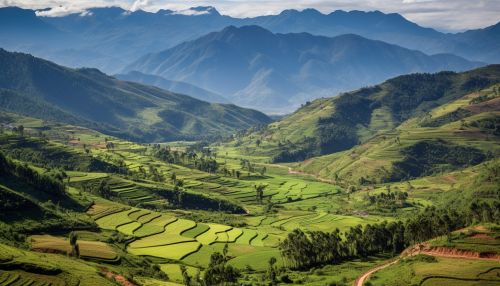Muisca Confederation
Introduction
The Muisca Confederation was a loose confederation of different communities in the central highlands of present-day Colombia, South America. The Muisca people were one of the four great civilizations of the Americas, alongside the Aztec, Maya, and Inca civilizations. They were known for their advanced knowledge of astronomy, mathematics, and goldsmithing.


History
The Muisca Confederation was established around the 12th century AD and lasted until the Spanish conquest in the 16th century. The confederation was not a kingdom, but a group of independent city-states, each with its own ruler, known as a cacique. The caciques were responsible for the administration of their territories, but they also participated in a larger council that made decisions affecting the entire confederation.
Society and Culture
The Muisca society was complex and hierarchical, with a clear division of labor and social roles. The society was divided into two classes: the muzos (nobles) and the hoysques (commoners). The muzos were the ruling class, consisting of the caciques and their families, while the hoysques were the working class, responsible for farming, crafting, and other labor-intensive tasks.
The Muisca culture was rich and diverse, with a strong emphasis on religion and ritual. The Muisca people believed in multiple gods and goddesses, each responsible for different aspects of life and nature. They practiced various rituals and ceremonies to honor these deities, including the famous El Dorado ceremony, in which the cacique would cover himself in gold dust and dive into a sacred lake.
Economy
The economy of the Muisca Confederation was based on agriculture, trade, and goldsmithing. The Muisca people were skilled farmers, growing a variety of crops, including maize, potatoes, and beans. They also raised llamas and guinea pigs for meat and wool.
Trade was an essential part of the Muisca economy. The Muisca people traded with neighboring tribes and civilizations, exchanging goods such as gold, emeralds, cotton textiles, and salt. They also developed a complex system of roads and paths to facilitate trade and communication.
Goldsmithing was a significant aspect of the Muisca economy and culture. The Muisca people were renowned for their intricate gold work, creating beautiful and detailed pieces of jewelry and religious artifacts. The abundance of gold in the Muisca territories attracted the attention of the Spanish conquistadors, leading to the eventual downfall of the confederation.
Spanish Conquest
The Spanish conquest of the Muisca Confederation began in 1537, led by conquistador Gonzalo Jiménez de Quesada. The Muisca people initially resisted the Spanish invasion, but they were eventually defeated due to the superior weaponry and tactics of the Spanish forces.
The Spanish conquest had a profound impact on the Muisca people and their culture. The Spanish imposed their language, religion, and customs on the Muisca people, leading to the loss of many aspects of their traditional culture. However, despite these changes, the Muisca people have managed to preserve some elements of their culture and continue to contribute to the cultural diversity of Colombia today.
